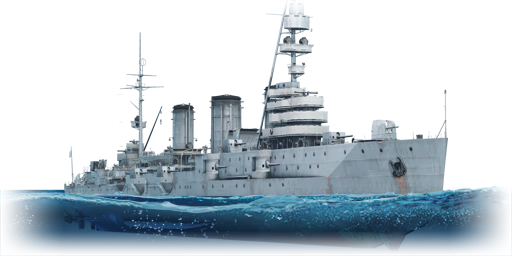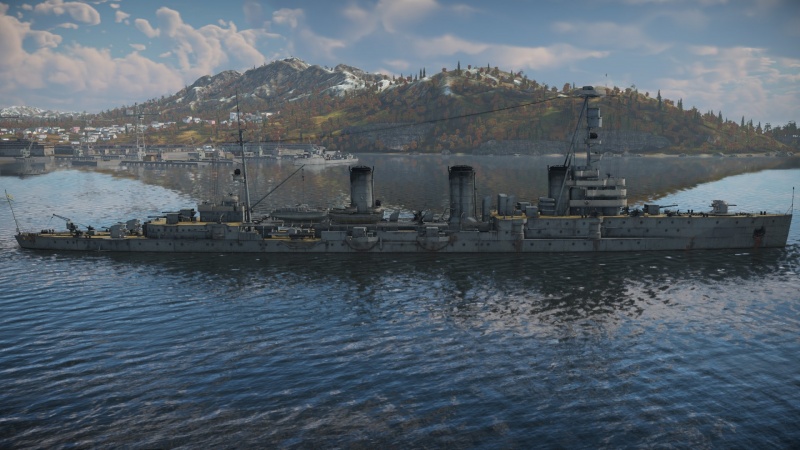Krasny Krym
Contents
Description
The Svetlana-class, Krasny Krym, 1943 (Red Crimea) is a rank III Soviet light cruiser with a battle rating of 5.3 (AB/RB/SB). It was introduced in Update 1.85 "Supersonic".
A modernized Svetlana-class light cruiser, Krasny Krym's WW1 origins are evident from its large amounts of casemate and single gun turrets, laid across the ship's sides. It is armed with 15 x 130 mm guns, arranged in single mounts; while on paper this may seem impressive, it can fire only a maximum of 8 guns at one target, which with its low calibre for its type means it won't do as much damage as other cruisers. The Krasny Krym is also very slow: while its counterparts steam at around 50 - 60 km/h, Krasny Krym's max speed is 48 km/h, only 3 km/h faster than HMS Dreadnought. However, where the Krasny Krym does shine is in its survivability; it has up to 75 mm of cemented armour, making it one of the most heavily armoured of its tier, which if effectively angled can stop heavy cruiser guns. Along with the armour is a huge crew of 852 men which allows for the Krasny Krym to survive more hits than its counterparts and keep fighting. Like other cruisers of its tier, Krasny Krym has a good AA battery which is good at shooting down or deterring enemy planes.
General info
Survivability and armour
Talk about the vehicle's armour. Note the most well-defended and most vulnerable zones, e.g. the ammo magazine. Evaluate the composition of components and assemblies responsible for movement and manoeuvrability. Evaluate the survivability of the primary and secondary armaments separately. Don't forget to mention the size of the crew, which plays an important role in fleet mechanics. Save tips on preserving survivability for the "Usage in battles" section. If necessary, use a graphical template to show the most well-protected or most vulnerable points in the armour.
Mobility
Write about the ship's mobility. Evaluate its power and manoeuvrability, rudder rerouting speed, stopping speed at full tilt, with its maximum forward and reverse speed.
| Mobility Characteristics | |||
|---|---|---|---|
| Game Mode | Upgrade Status | Maximum Speed (km/h) | |
| Forward | Reverse | ||
| AB | |||
| Upgraded | 48 | 13 | |
| RB/SB | |||
| Upgraded | 41 | 11 | |
Modifications and economy
Armament
Primary armament
The 130 mm cannons can be described in one word - inadequate. Being destroyer calibre guns mounted on an outdated cruiser chassis they should be treated as such. Do not expect to knock out anything you would not be able to with late Soviet destroyers, the shells are not something you will be proud of. They also have quite low velocity, so you will most likely have troubles with accuracy at range, and much lower explosive mass than other cruisers. Aiming whole broadside is also somewhat difficult, since the guns do not share levels of elevation nor horizontal guidance. Let that not scare you however, for they do have some redeeming qualities.
First off, they are quite numerous. A full HE broadside of 8 guns can be quite devastating for anything unarmoured, but do not wish for miracles. When fighting against DDs you can feel relatively comfortable, blacking out a few compartments at once, but facing any cruiser you should try to aim to disable the enemy's armament first, as you do not have the power or reload to overpower them. You will have serious disadvantage against them but you can dish out some pain if you're lucky, especially since you'll be far from the top of the priority target list.
The guns apart from being numerous are quite spaced out and have relatively thick gun shields. You can safely assume that you will be able to return fire from at least a few guns until the bitter end, since the possibility of rendering all of them useless is quite low. Even if after facing a few salvos one side of the ship is inoperable, you have old-school broadside cruiser at your disposal, you can always turn the other way and respond with the other side's guns.
Also, remember that you have big ammo reserves, 175 shells per gun at full load - you can be liberal with your fire should you want to.
Secondary armament
Some ships are fitted with weapons of various calibres. Secondary armaments are defined as weapons chosen with the control Select secondary weapon. Evaluate the secondary armaments and give advice on how to use them. Describe the ammunition available for the secondary armament. Provide recommendations on how to use them and which ammunition to choose. Remember that any anti-air armament, even heavy calibre weapons, belong in the next section. If there is no secondary armament, remove this section.
Anti-aircraft armament
An important part of the ship's armament responsible for air defence. Anti-aircraft armament is defined by the weapon chosen with the control Select anti-aircraft weapons. Talk about the ship's anti-air cannons and machine guns, the number of guns and their positions, their effective range, and about their overall effectiveness – including against surface targets. If there are no anti-aircraft armaments, remove this section.
Additional armament
Unfortunately, Krasny Krym's torpedoes are not very effective. There are only 3 per side, and with only a maximum range of 4 km, they are only useful when you are extremely close to your target where your thick armour is useless or are caught by surprise by a flanking destroyer. It may be wise to not take them at all to eschew the risk of the torpedoes exploding to enemy fire.
Usage in battles
Describe the technique of using this ship, the characteristics of her use in a team and tips on strategy. Abstain from writing an entire guide – don't try to provide a single point of view, but give the reader food for thought. Talk about the most dangerous opponents for this vehicle and provide recommendations on fighting them. If necessary, note the specifics of playing with this vehicle in various modes (AB, RB, SB).
Pros and cons
Pros:
- Surprisingly survivable
- Ship is well armoured for its type, up to 75 mm
- Massive crew, allows it to take a lot of hits and keep going
- Strong AA armament
- 10 x 37 mm autocannons, effective at shooting down aircraft
- Large ammo reserves, 2625 rounds can last an entire match
- Easily overlooked if there are more dangerous ships on the field
- When facing enemy head-on, slightly angled, most primary guns can be fired
Cons:
- Lacking firepower
- Destroyer calibre guns means less damage against enemy ships
- Reload is about the same as other 152 mm gun-armed cruisers
- Low-range and small amount of torpedoes mean they are only effective when you are far too close to an enemy
- Sluggishly slow, similar to some battleships
- Not manoeuvrable at all, large turning circle makes it somewhat hard to dodge torpedoes, bombs, and enemy fire
History
Krasny Krym was initially laid down in 1913 under the name 'Svetlana', and was the lead ship of her class of four. Svetlana-class light cruisers were intended for the Baltic Fleet of the Imperial Russian Navy and were therefore designed slightly differently in comparison to the closely-related, intended for Black Sea operations, Admiral Nakhimov-class (of which the already familiar Krasny Kavkaz was a part of).
By late 1917, Svetlana was nearing completion. In the meantime however, the Russian Empire was beginning to collapse and the ensuing revolutions, followed by a civil war, halted construction. After the establishment of the Soviet Union, work on the Svetlana continued in 1924, with the ship being renamed 'Profintern'.
Work on the Profintern finally finished in July 1928, with the ship's completed layout closely resembling the original one. Instead of being commissioned into service with the Baltic Fleet as originally planned, Profintern was instead assigned to the ranks of the Black Sea Fleet in 1929.
Throughout the '30s, the Profintern underwent substantial overhaul works, with her auxiliary weapon systems being upgraded and fire control systems improved. Shortly after the outbreak of WW2, the ship was renamed for the second and last time to Krasny Krym in October 1939.
Krasny Krym, similarly to her half-sister Krasny Kavkaz, served the entirety of WW2 as part of various operations in the Black Sea region. Most notably, taking part in the Siege of Sevastopol and the Kerch-Feodosiya Operation. As such, the ship was primarily tasked with escorting various convoys, evacuating and transporting troops as well as bombarding enemy positions with artillery fire. For her performance, Krasny Krym was also awarded with the elite Guards title in June 1942.
Following the end of WW2, Krasny Krym remained in active service for some time, although repurposed on several occasions. July 1959 marked the end of the ship's service, with Krasny Krym being ultimately sold for scrap.
- From Devblog
Media
Excellent additions to the article would be video guides, screenshots from the game, and photos.
See also
Links to articles on the War Thunder Wiki that you think will be useful for the reader, for example:
- reference to the series of the ship;
- links to approximate analogues of other nations and research trees.
External links
| Baltic Shipyard (Балтийский завод) | |
|---|---|
| Light Cruisers | |
| Svetlana-class | Krasny Krym* |
| Project 26/26bis | Kirov · Maxim Gorky |
| Project 68 | Chapayev |
| Project 68bis | Sverdlov |
| Battlecruisers | |
| Izmail-class | Izmail |
| Battleships | |
| Sevastopol-class | Marat · Parizhskaya Kommuna |
| *Laid down at the Russian-Baltic shipyard in Tallinn | |
| USSR light cruisers | |
|---|---|
| Imperial Russia | |
| Svetlana-class | Krasny Krym* · Krasny Kavkaz* |
| * Laid down by Imperial Russian Navy; Finished and renamed by the USSR | |
| Project | Soviet Union |
| Pr.26 | Kirov · Voroshilov · Maxim Gorky |
| Pr.68 | Chapayev · Zheleznyakov |
| Pr.68-bis | Sverdlov · Mikhail Kutuzov |
| Pr.68-bis-ZiF | Shcherbakov |
| Trophies | Italy |
| Condottieri-class | Kerch |





